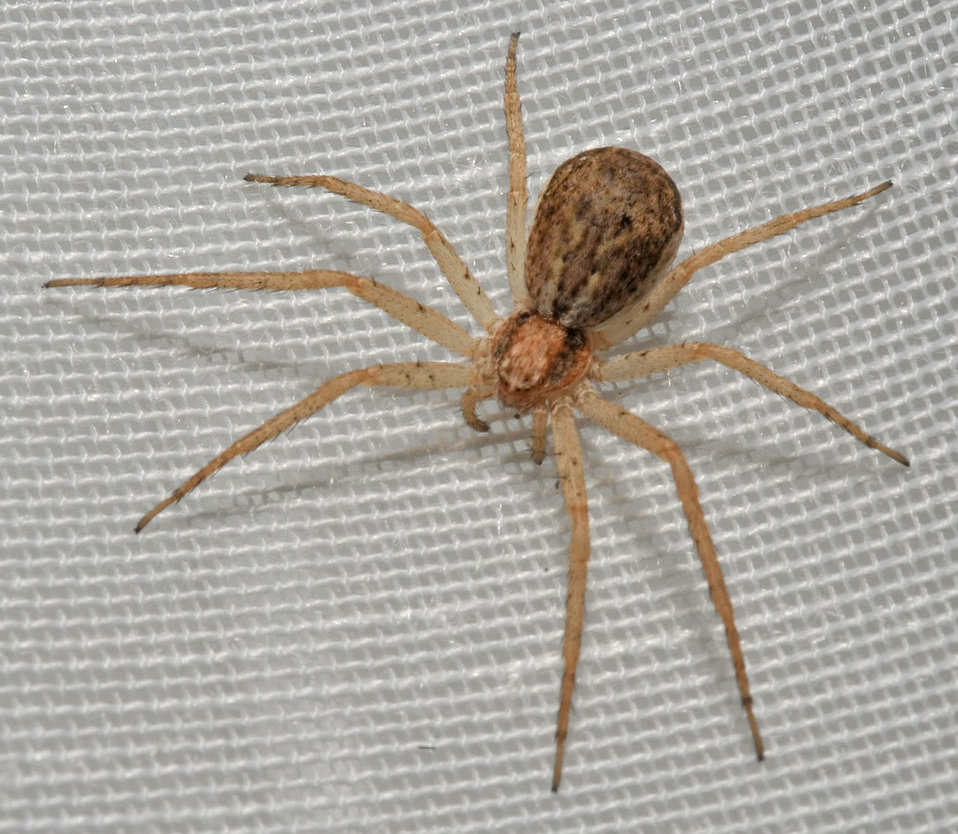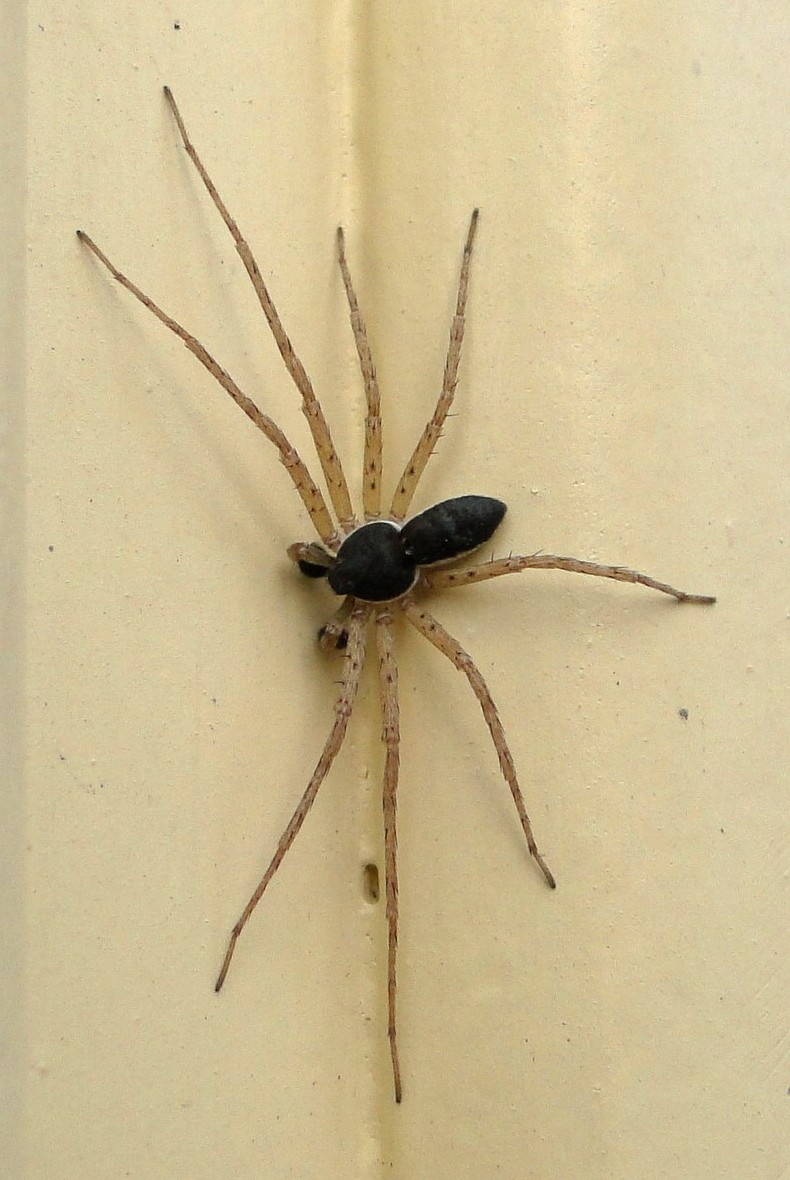- Home
- Garden Wildlife
- Arthropods
- Arachnids
- Spiders
- Hunting spiders
Hunting Spiders
This page covers those many spiders that do not construct silken webs in order to snare food, although all can make silk, and most use it in reproduction. The earliest spiders, from the Carboniferous period 300m years ago did not make webs, and their descendents persist as trap-door spiders. There are several families of spiders that hunt - either actively or by lurking, but they are not more related among each other than to the web-builders.
Jennifer Owen recorded 25 non-web-builders from nine families in her garden, out of her spider total of 79. While some hunting spiders can be found indoors, most live in the garden and can be found on plants or running over the soil. We cover them here by family.
Ground spiders - Gnaphosidae
There are about 33 British and Irish species in this family. Ground spiders are largely nocturnal mobile predators, that retreat to a silken lair in the daytime. They are relatively large and bulky spiders, and Owen recorded two species,
Drassodes lapidosus which favours stone piles and the mouse-spider Scotophaeus blackwalli which likes sheds, fences and bark on dead trees. The latter gets its common name form the silky grey hairs on its abdomen.
Diving bell Spider Dictynidae
The diving-bell spider Argyroneta aquatica is an aberrant member of the Dictynidae, which are mostly terrestrial web builders. It is the only spider that lives its life under water, although sometimes leaving the water to moult, or when very young. It comes to the surface to collect air which it traps in the hairs on its body, giving a silvery appearance. It releases the air in a diving-bell-shaped silk retreat, which it lives in and uses for feeding, mating and egg laying. They seal up the bell and over-winter within it. They are skilful swimmers, and can catch and eat a variety of prey including small fish. This spider is capable of giving quite a bite, similar to a bee sting in effect. The species is widespread, but not common, and may be declining. They are recorded from garden ponds, but they will need to be very clean and clear to support the species.
Male and female diving bell spiders Argyroneta aquatica and an old print showing the diving-bell. If you could supply a proper photo that would be much appreciated!
Other sources of information
Website
Web site of the British Arachnological Society
Steven Falk's excellent Araneae photos in many albums
British Spiders Facebook Group
British Spider Identification Facebook Group
Books
Bee, L, Oxford, G and Smith, H. (2020) Britain's Spiders: A Field Guide Second Edition. WILDGuides (due September 2020)
Jones, D. (1995). The Country Life Guide to Spiders of Britain and Northern Europe. Country Life Books
Jones-Walters, L.M. (1989) Keys to the families of British spiders. A Field Studies Council AIDGAP key
Roberts, M. J. (2001) Collins Field Guide: Spiders of Britain and Northern Europe. Harper Collins
Roberts, M. J. (1993). The Spiders of Great Britain and Ireland, Compact edition (2 Vols) Harley Books
Page text drafted by Andrew Halstead, reviewed by Andrew Salisbury, extended and compiled by Steve Head
oonopidae oonops pulcher O.domesticus Owen 2
Drassodes lapidosus mouse-spider Scotophaeus blackwalli
Foliage spiders Clubionidae
These are also called sac-spiders, after the silken pouch hidden in a rolled leaf or among debris, in which they hide in the daytime before emerging to hunt at night. It is a large family, with 24 British and Irish species, of which Jennifer Owen recorded seven species in the genus Clubiona. C. terrestris and C. pallidula are common in gardens.
Wolf spiders Lycosidae
As their name implies, these are active chasing hunters with relatively large bodies. They have particularly good vision, and have a reflecting layer in their main eyes which increases their sensitvity in low light conditions. Female wolf spiders usually carry their egg-sac with them, attached to their posterior spinnerets. There are about 40 British and Irish species, and Jennifer Owen recorded four species in her garden. Pardosa amentata is one of the commonest species, found in sunny grassy spots. The other species she found were Pardosa pullata, Pardosa prativaga and
Alopecosa pulverulenta.
Female Clubiona pallidula
Crab spiders Thomisiidae
These are called crab spiders because of the way they hold up their first pair of legs like crab claws, and because they tend to scuttle sideways like crabs. Other families have species called "crab spider" and the Thomisiidae are sometimes called flower-crab or flower spiders. Jennifer Owen recorded three species in her garden. The female Misumena vatia, a flower-crab spider, is an ambush predator that waits motionless in a flower head for a pollinating insect to arrive. They gradually change their colour to be camouflaged against the flower on which they are sitting, and can be hard to see until they move, The male is very much smaller and not camouflaged.
Top: Wolf spider Pardosa amentata - second photo shows female with egg sac
Below: Left: Pardosa pullata with spiderlings, Centre Pardosa prativaga, Right: Alopecosa pulverulenta
Jumping spiders Salticidae
This is the largest spider family globally, and has nearly 40 species in Britain and Ireland. They are small but very active spiders, with excellent vision from 4 large forward-facing eyes, can be seen on walls and fences. They hunt by creeping up on prey they have spotted, and then pouncing with a jump at the last moment. Jennifer Owen found two species in her garden, the zebra spider Salticus scenicus, and the sun jumping spider Heliophanus flavipes. Another species Pseudeuophrys lanigera from western Europe was first found in southern England in 1930, and is spreading northwards to Scotland. It is strongly associated with houses, perhaps benefiting from central heating.
Green crab spider Diaea dorsata crab-spider Ozyptila praticola crab spider Xysticus cristatus
Running crab spiders Philodromidae
There are about 20 species of this family in Britain and Ireland, and Jennifer Owen recorded the following three species in her garden. Most Philodromids are rather flattened in shape, with long legs, and can run very fast when disturbed. Philodromus dispar is common on trees, and the female is light brown while the male is black, both having a paler lateral stripe. Philodromus aureolus is also very common in spring and summer on trees and bushes; the female is reddish-brown, but the male has blue-purple iridescence. The third species, Tibellus oblongus has a very elongated body, rounded in section, allowing them to stretch out and be camouflaged against the grass stems within which they live, especially in damp places.
Jumping spiders. Zebra spider Salticus scenicus, sun jumping spider Heliophanus flavipes, Pseudeuophrys lanigera
Woodlouse spider Dysderidae
This relatively small spider family is specialised to feed on woodlice, which most spiders can't attack, by having large chelicerae biting horizontally. There are three British and Irish species, of which the best known is Dysdera crocata. Jennifer Owen found Harpactea hombergi, which is darker, in her garden.
Woodlouse spiders: Dysdera crocata. Harpactea hombergi (museum specimen)
Nursery web spider Pisauridae
We have three species of this family in Britain and Ireland, but only Pisaura mirabilis is likely to be seen in gardens - where it is common. This large (10-15mm) spider is named from the way the female carries her large egg sac beneath her, then when the spiderlings are ready to hatch, she spins a silk "nursery tent" to protect them as they emerge. Generally the spider keeps its first two pairs of legs close together on each side of its body.
Nursery web spider Pisaura mirabilis. Nursery tent is shown on the right with the female on guard
Spitting spiders Scytodidae
There is only one species in this family in Britain, and while found in gardens, it is most commonly seen indoors. The spitting spider Scytodes thoracica is widespread but not common in southern Britain, and gets its name from a unique ability to spit a mixture of sticky glue and poison from its chelicerae, which glues its prey to the substrate so it can attack. It is small, and slow, and hunts mainly at night. The cephalothorax (fused head and thorax) is large and domed - close to spherical.
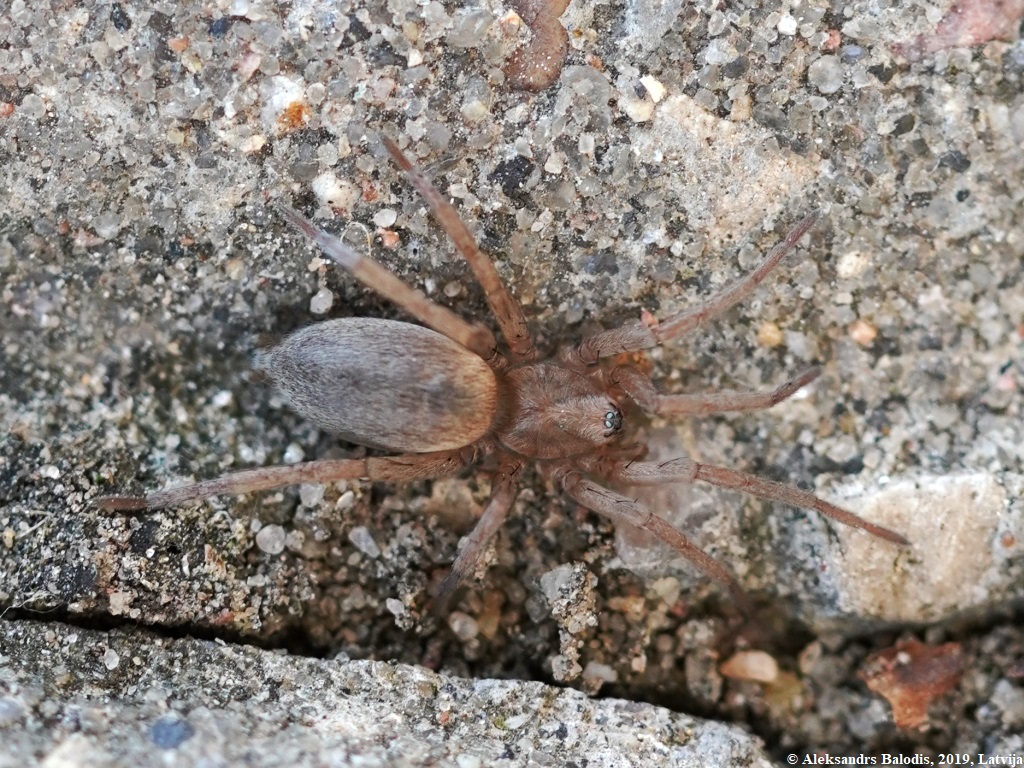
_(15528639683).jpg)
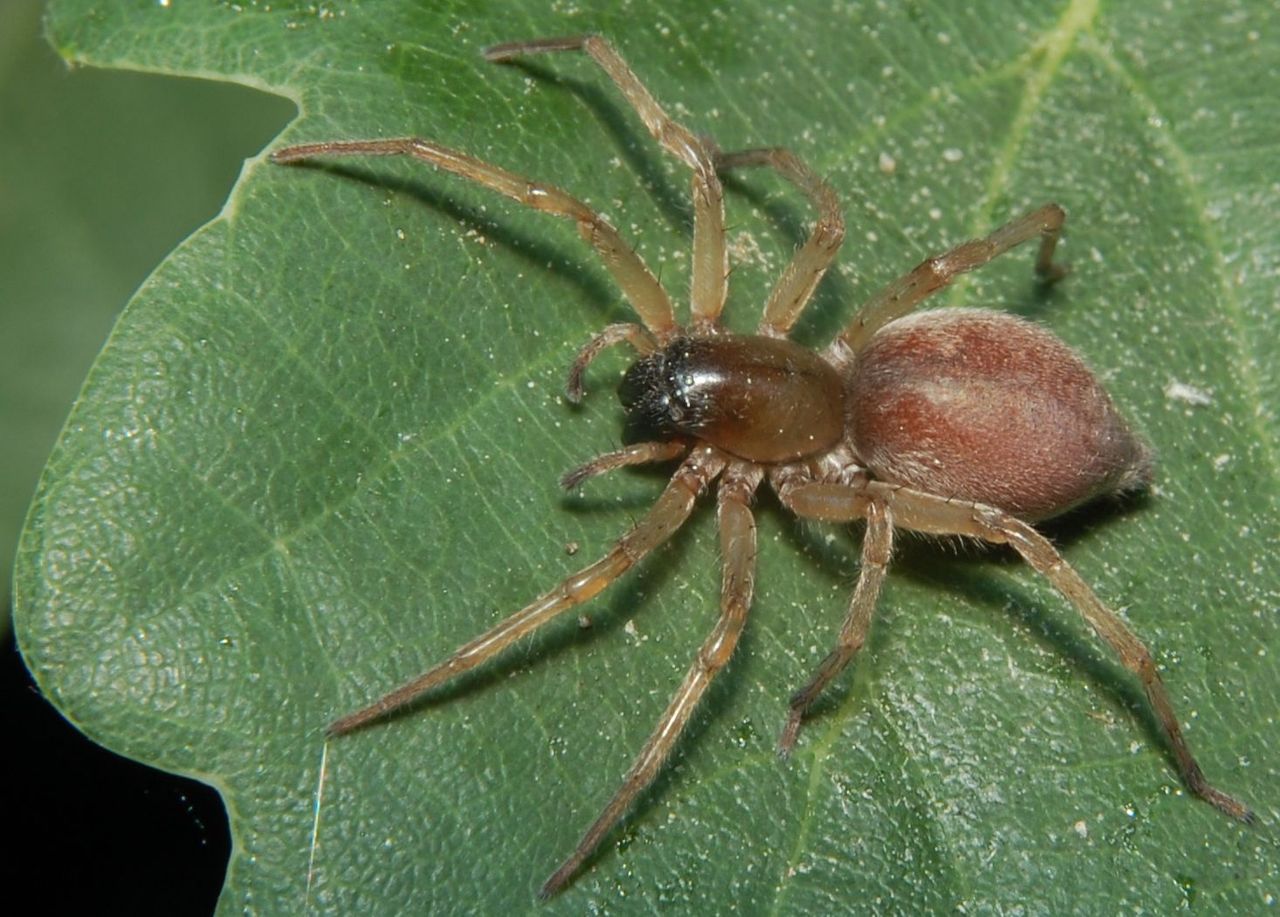
Large female flower-crab spider Misumena vatia 4mm male
In the green crab spider Diaea dorsata, the sexes are similar. This species likes shrubs and trees, especially evergreens such as box (Buxus) and conifers. Another crab-spider Ozyptila praticola is also associated with trees, on bark or lower branches, and especially in leaf litter. The crab spider Xysticus cristatus is very common, preferring open habitats, often lurking at the top of vegetation waiting to catch alighting insect prey, or ambushing walking insects at ground level
.jpg)
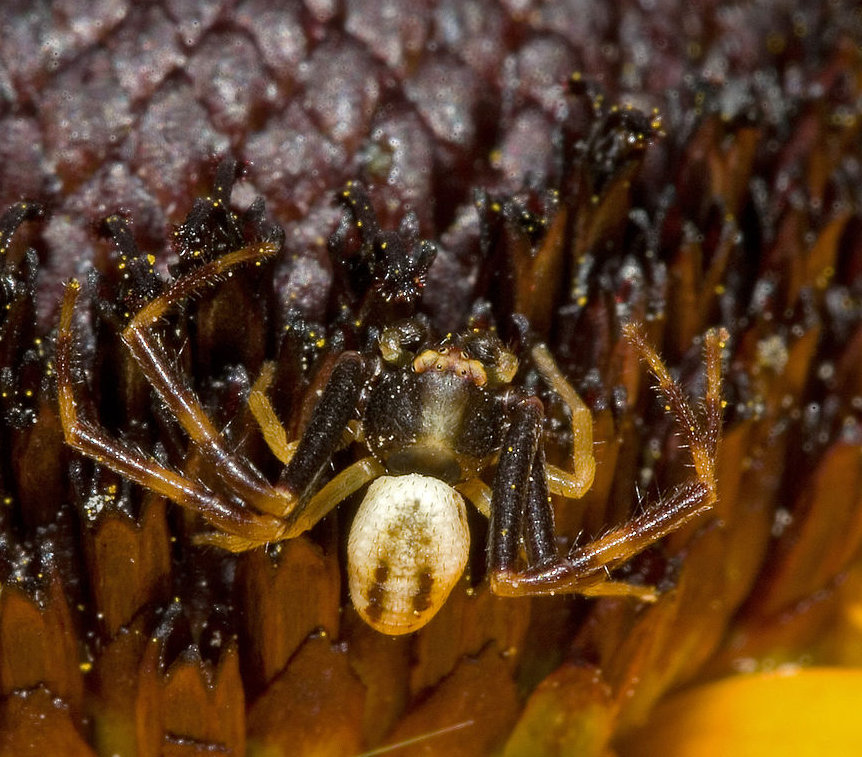
.jpg)
.jpg)
.jpg)
.jpg)
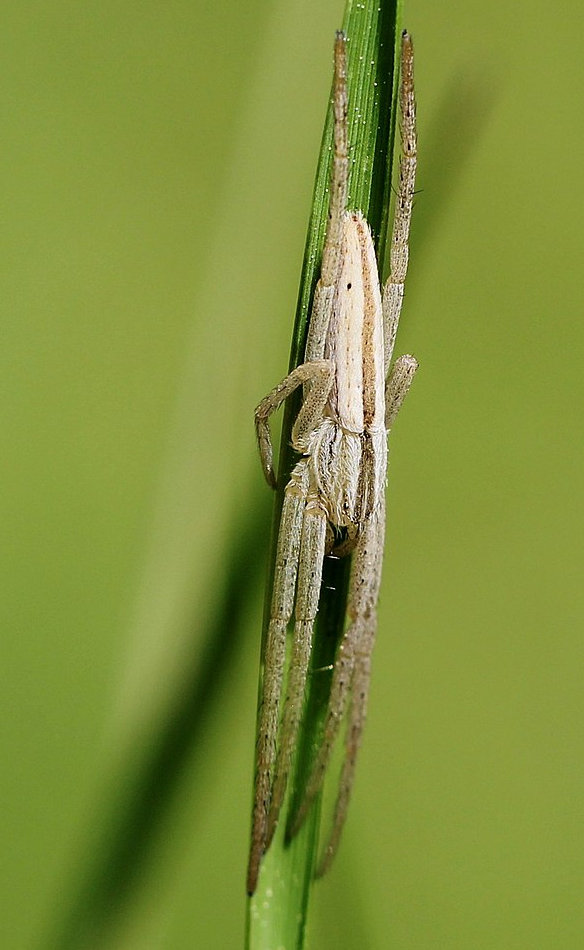
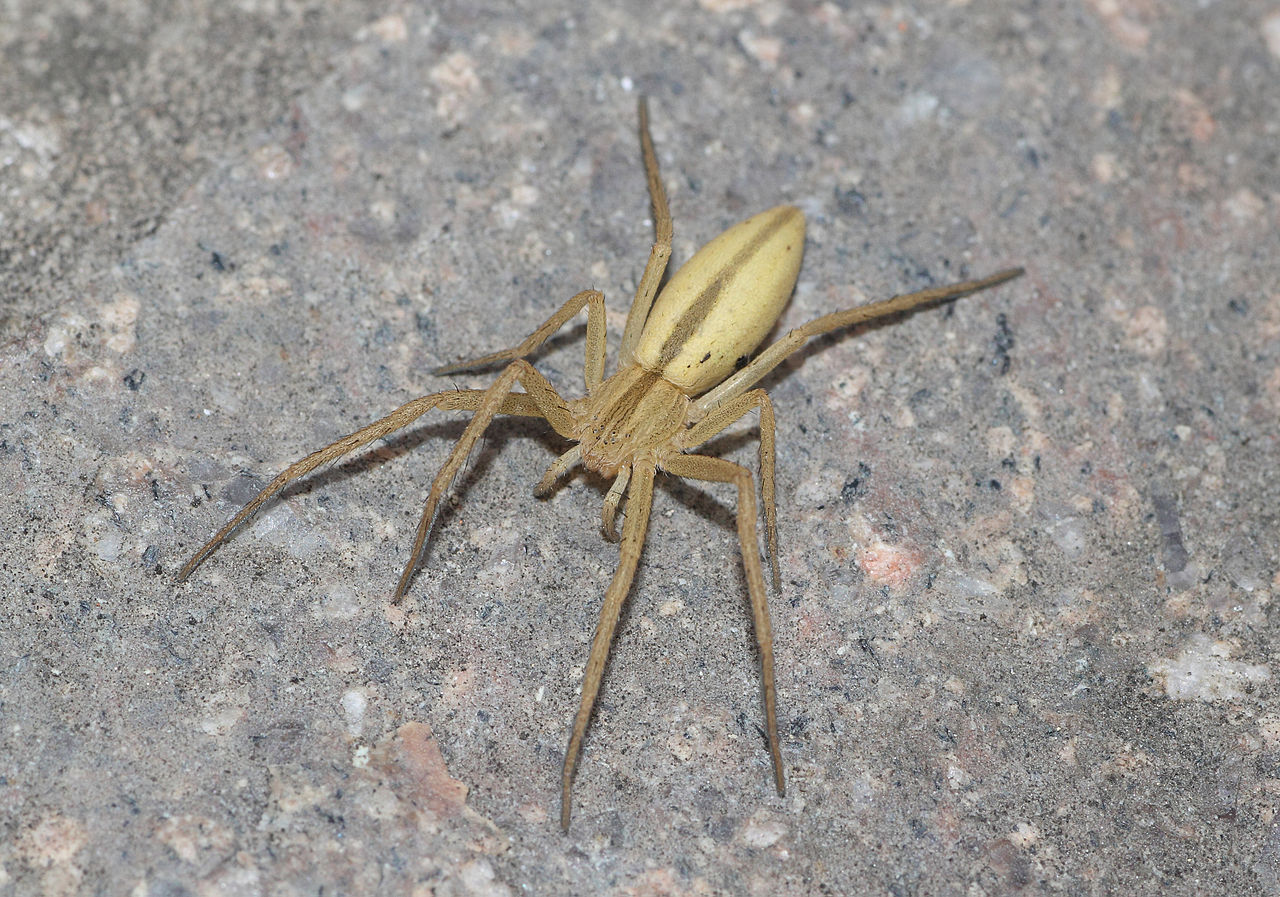
Philodromus dispar female (left) and male (centre) Right: male Philodromus aureolus
Tibellus oblongus with the second photo showing its typical posture stretched along a grass stem
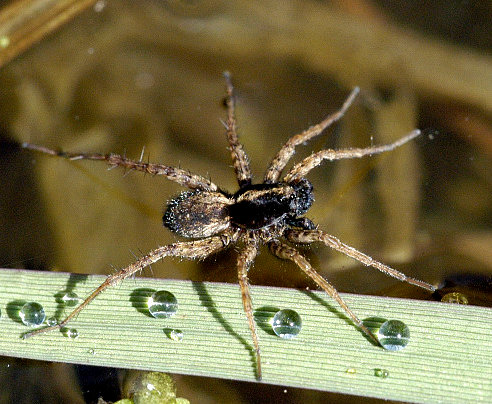
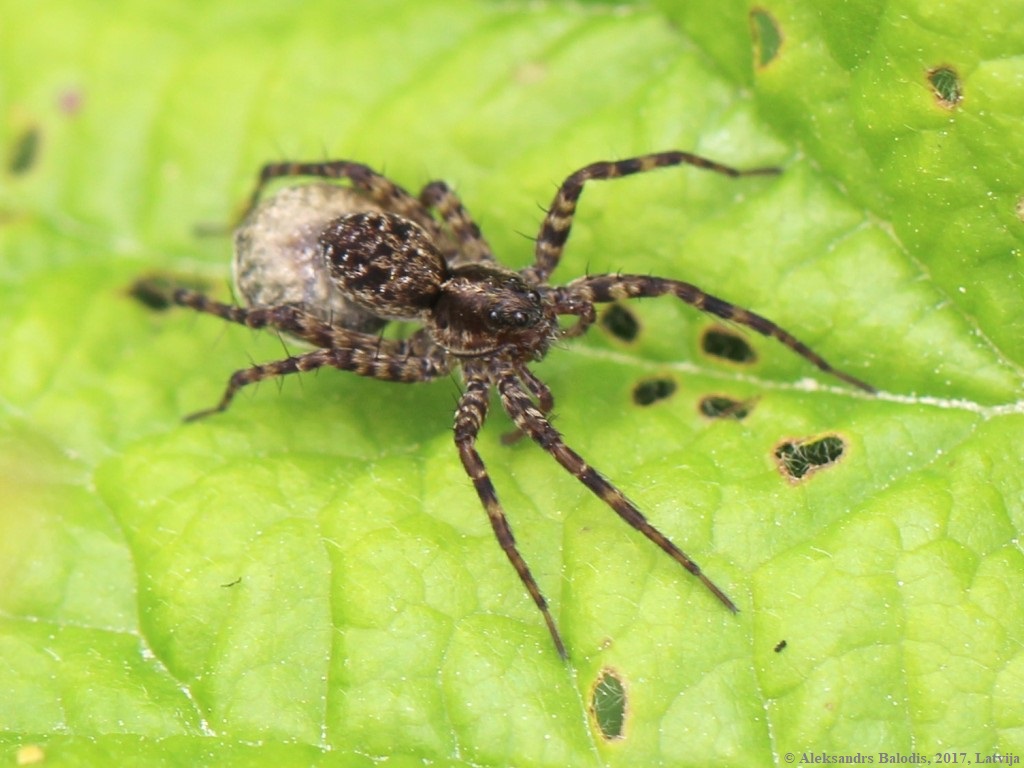
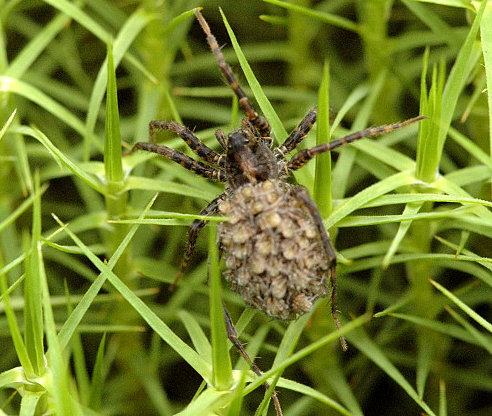
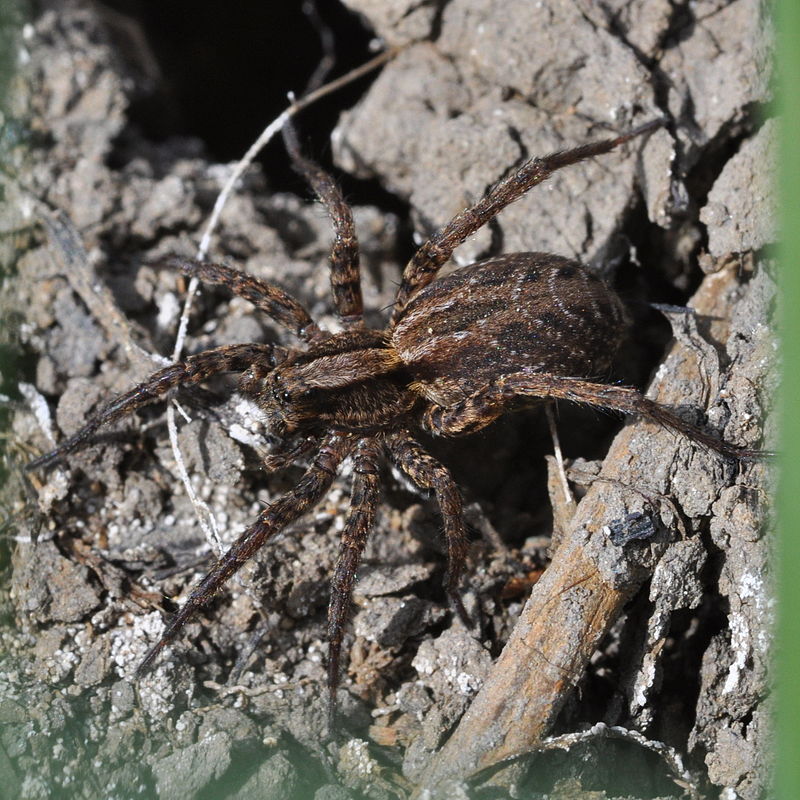
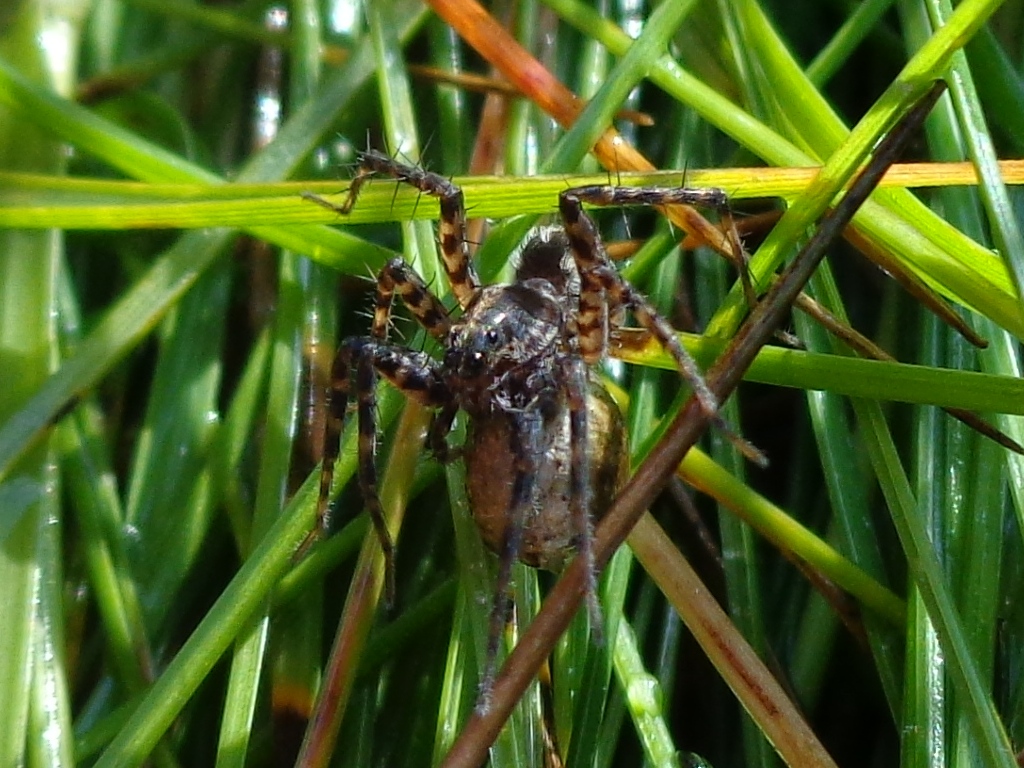
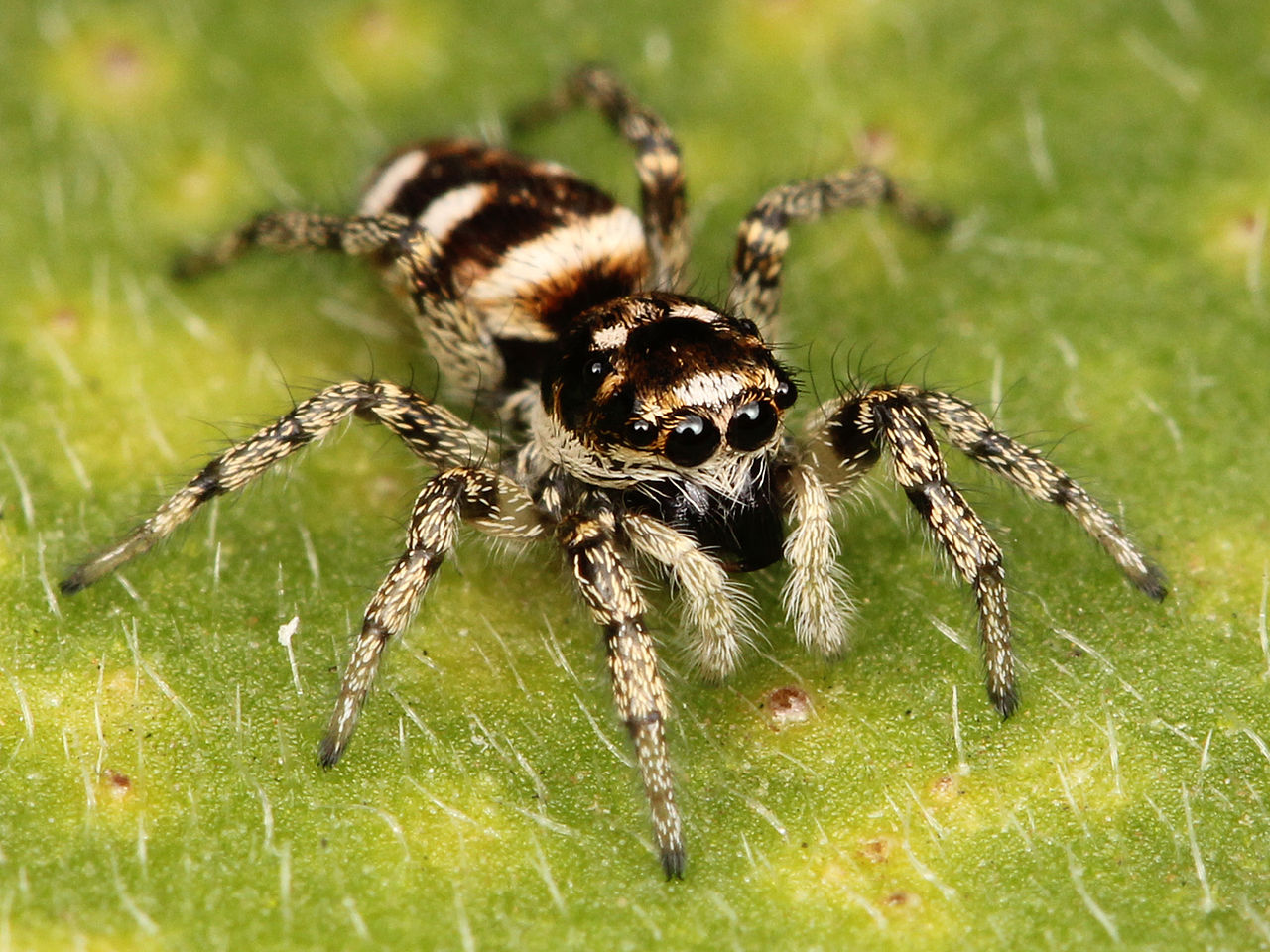
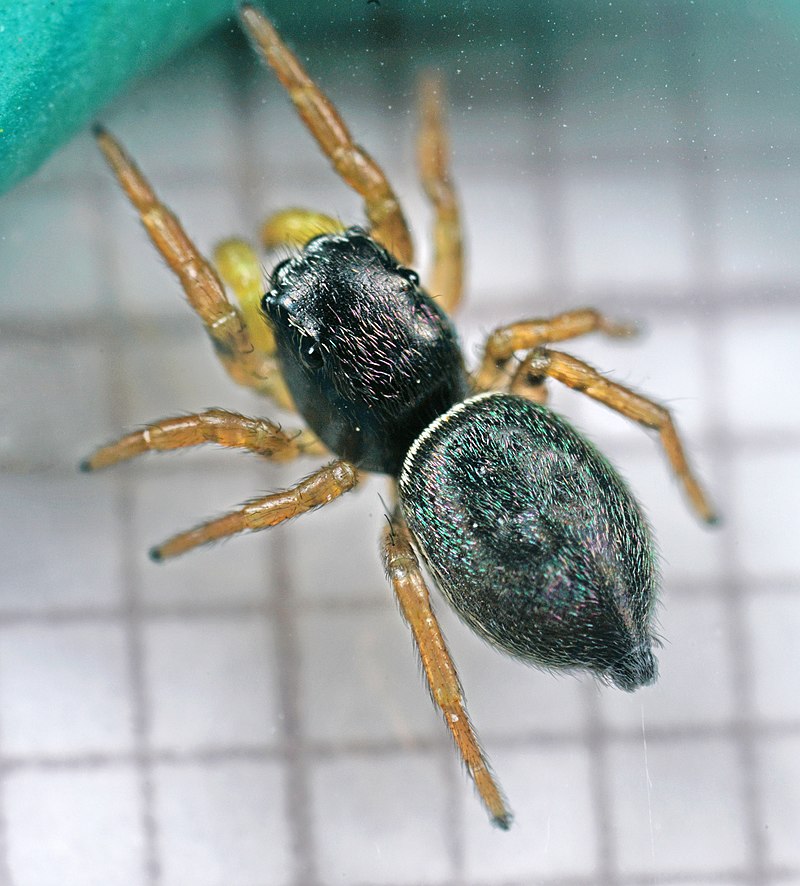
.jpg)
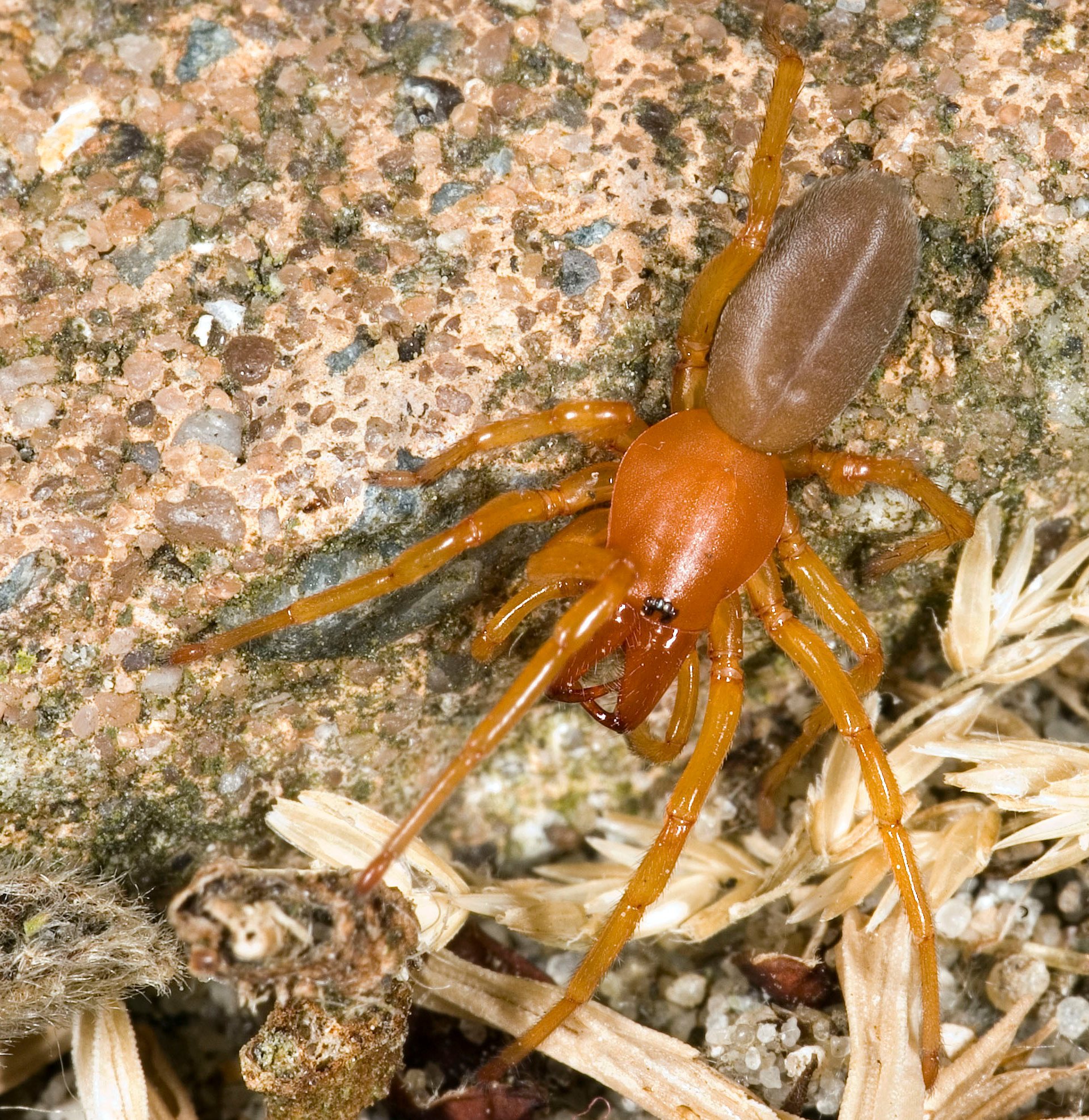
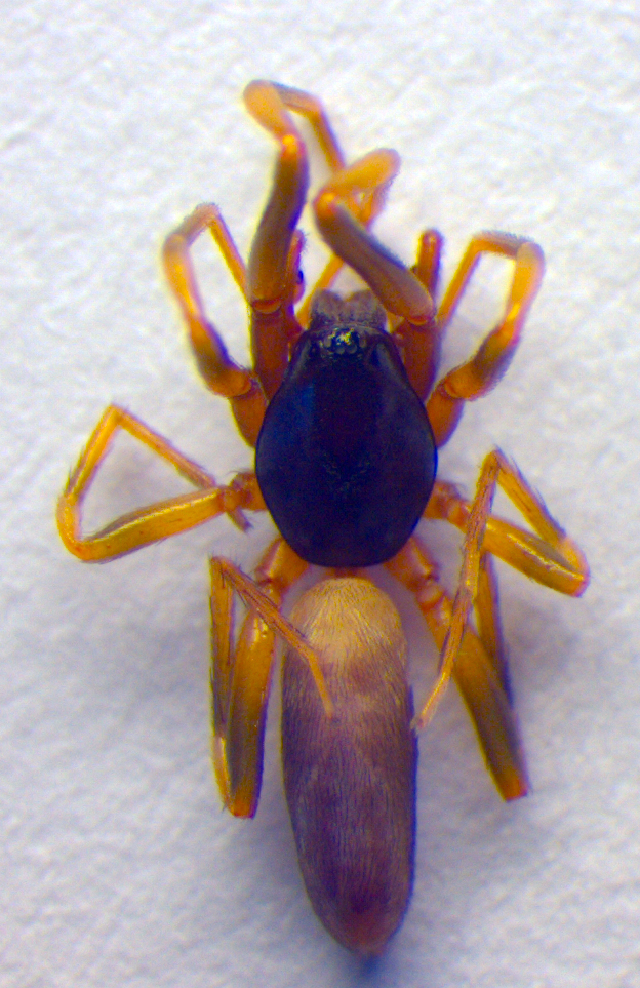
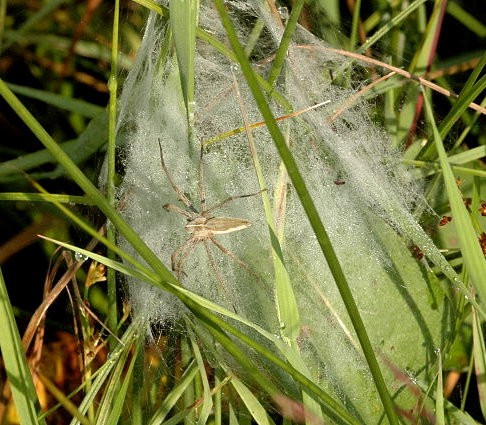
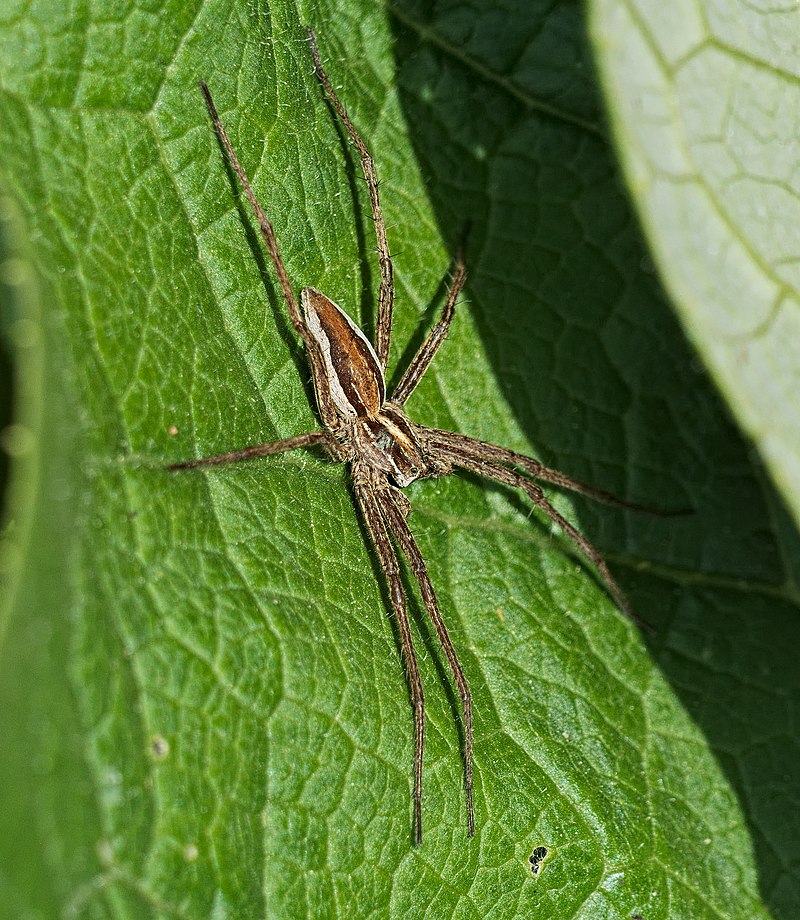
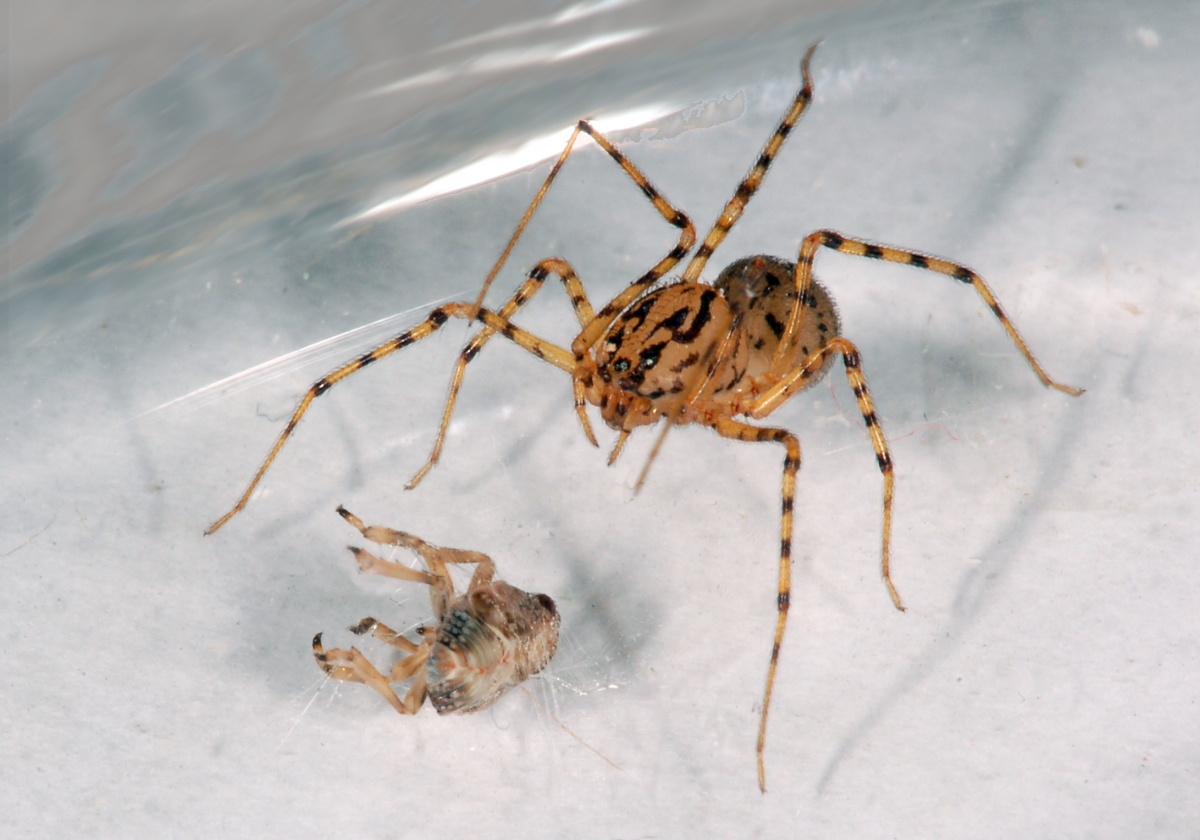
Spitting spider Scytodes thoracica with a small hemipteran prey which it has glued to the surface of the petri dish with its sticky spit.
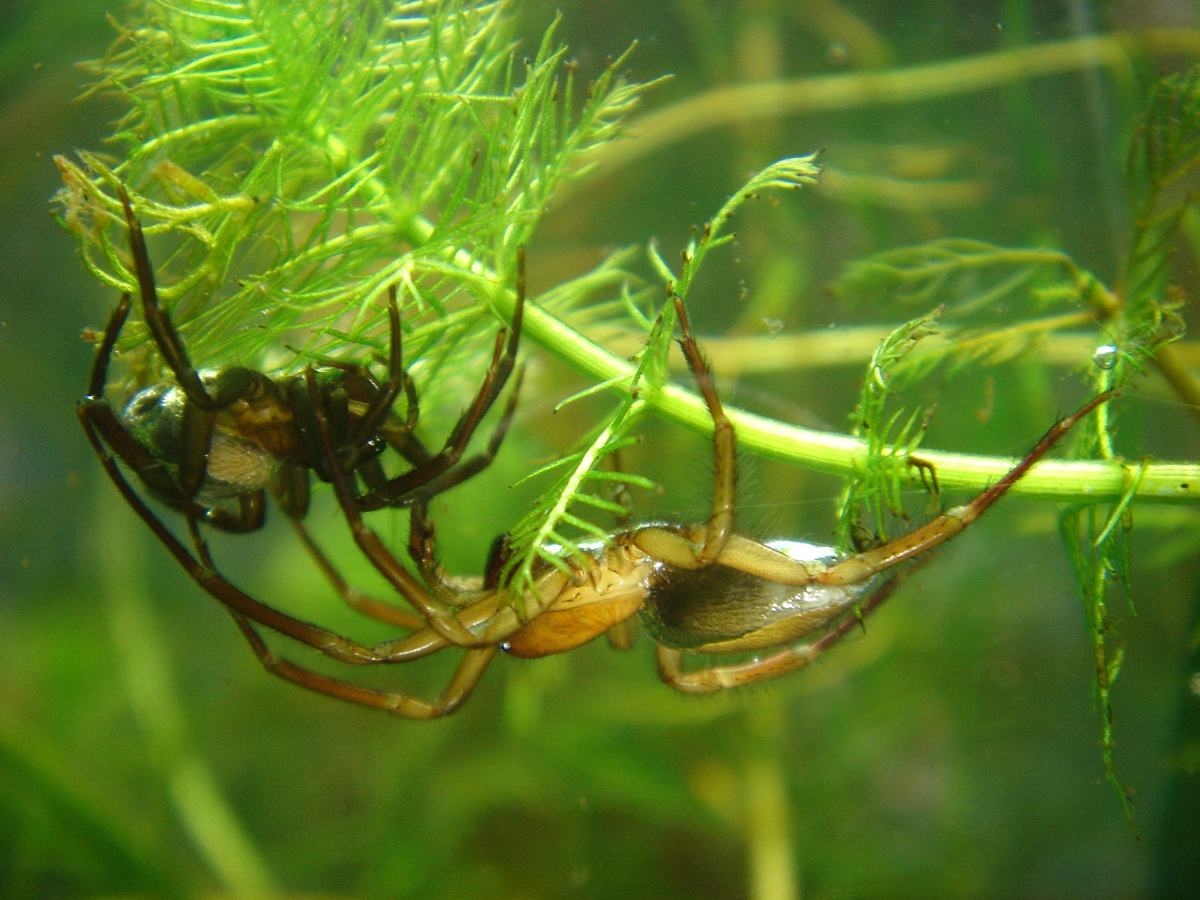
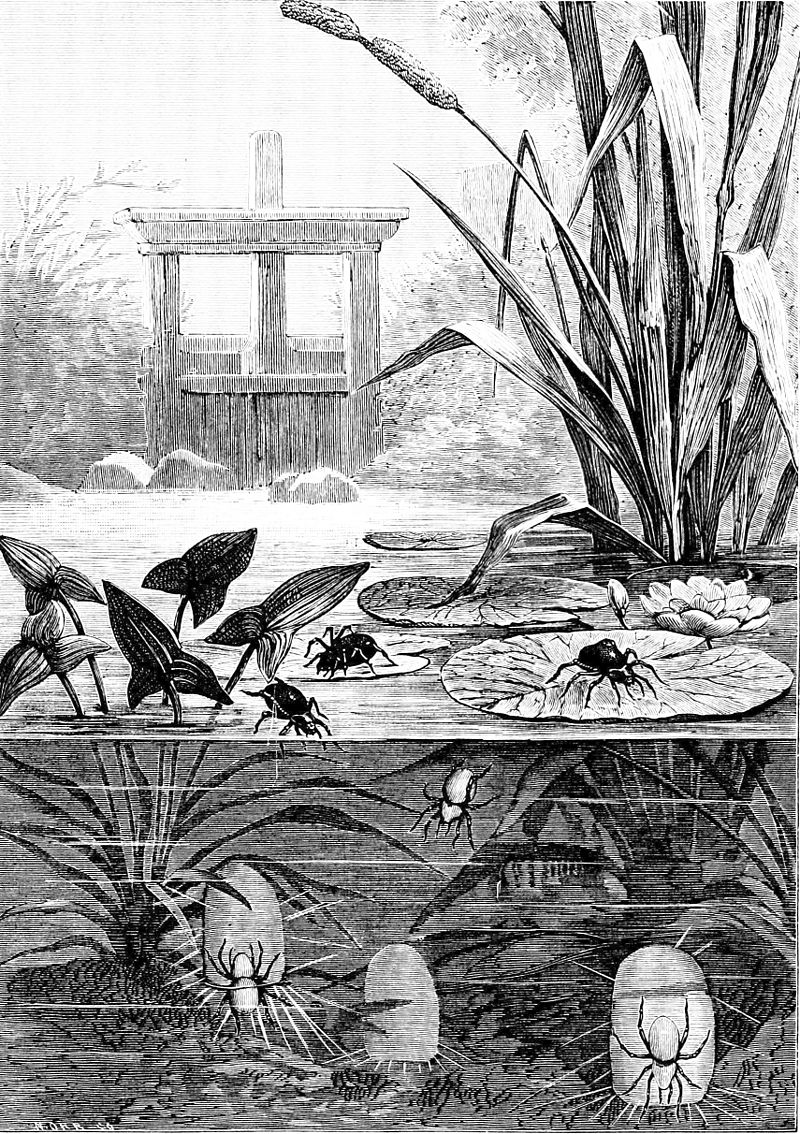
Hunting Spiders
This page covers those many spiders that do not construct silken webs in order to snare food, although all can make silk, and most use it in reproduction. The earliest spiders, from the Carboniferous period 300m years ago did not make webs, and their descendents persist as trap-door spiders. There are several families of spiders that hunt - either actively or by lurking, but they are not more related among each other than to the web-builders.
Jennifer Owen recorded 25 non-web-builders from nine families in her garden, out of her spider total of 79. While some hunting spiders can be found indoors, most live in the garden and can be found on plants or running over the soil. We cover them here by family.
Ground spiders - Gnaphosidae
There are about 33 British and Irish species in this family. Ground spiders are largely nocturnal mobile predators, that retreat to a silken lair in the daytime. They are relatively large and bulky spiders, and Owen recorded two species,
Drassodes lapidosus which favours stone piles and the mouse-spider Scotophaeus blackwalli which likes sheds, fences and bark on dead trees. The latter gets its common name form the silky grey hairs on its abdomen.
Hunting Spiders
This page covers those many spiders that do not construct silken webs in order to snare food, although all can make silk, and most use it in reproduction. The earliest spiders, from the Carboniferous period 300m years ago did not make webs, and their descendents persist as trap-door spiders. There are several families of spiders that hunt - either actively or by lurking, but they are not more related among each other than to the web-builders.
Jennifer Owen recorded 25 non-web-builders from nine families in her garden, out of her spider total of 79. While some hunting spiders can be found indoors, most live in the garden and can be found on plants or running over the soil. We cover them here by family.
Ground spiders - Gnaphosidae
There are about 33 British and Irish species in this family. Ground spiders are largely nocturnal mobile predators, that retreat to a silken lair in the daytime. They are relatively large and bulky spiders, and Owen recorded two species,
Drassodes lapidosus which favours stone piles and the mouse-spider Scotophaeus blackwalli which likes sheds, fences and bark on dead trees. The latter gets its common name form the silky grey hairs on its abdomen.
Hunting Spiders
This page covers those many spiders that do not construct silken webs in order to snare food, although all can make silk, and most use it in reproduction. The earliest spiders, from the Carboniferous period 300m years ago did not make webs, and their descendents persist as trap-door spiders. There are several families of spiders that hunt - either actively or by lurking, but they are not more related among each other than to the web-builders.
Jennifer Owen recorded 25 non-web-builders from nine families in her garden, out of her spider total of 79. While some hunting spiders can be found indoors, most live in the garden and can be found on plants or running over the soil. We cover them here by family.
Ground spiders - Gnaphosidae
There are about 33 British and Irish species in this family. Ground spiders are largely nocturnal mobile predators, that retreat to a silken lair in the daytime. They are relatively large and bulky spiders, and Owen recorded two species,
Drassodes lapidosus which favours stone piles and the mouse-spider Scotophaeus blackwalli which likes sheds, fences and bark on dead trees. The latter gets its common name form the silky grey hairs on its abdomen.
Hunting Spiders
This page covers those many spiders that do not construct silken webs in order to snare food, although all can make silk, and most use it in reproduction. The earliest spiders, from the Carboniferous period 300m years ago did not make webs, and their descendents persist as trap-door spiders. There are several families of spiders that hunt - either actively or by lurking, but they are not more related among each other than to the web-builders.
Jennifer Owen recorded 25 non-web-builders from nine families in her garden, out of her spider total of 79. While some hunting spiders can be found indoors, most live in the garden and can be found on plants or running over the soil. We cover them here by family.
Ground spiders - Gnaphosidae
There are about 33 British and Irish species in this family. Ground spiders are largely nocturnal mobile predators, that retreat to a silken lair in the daytime. They are relatively large and bulky spiders, and Owen recorded two species,
Drassodes lapidosus which favours stone piles and the mouse-spider Scotophaeus blackwalli which likes sheds, fences and bark on dead trees. The latter gets its common name form the silky grey hairs on its abdomen.

Female Clubiona pallidula
Crab spiders Thomisiidae
These are called crab spiders because of the way they hold up their first pair of legs like crab claws, and because they tend to scuttle sideways like crabs. Other families have species called "crab spider" and the Thomisiidae are sometimes called flower-crab or flower spiders. Jennifer Owen recorded three species in her garden. The female Misumena vatia, a flower-crab spider, is an ambush predator that waits motionless in a flower head for a pollinating insect to arrive. They gradually change their colour to be camouflaged against the flower on which they are sitting, and can be hard to see until they move, The male is very much smaller and not camouflaged.
.jpg)

Large female flower-crab spider Misumena vatia 4mm male
In the green crab spider Diaea dorsata, the sexes are similar. This species likes shrubs and trees, especially evergreens such as box (Buxus) and conifers. Another crab-spider Ozyptila praticola is also associated with trees, on bark or lower branches, and especially in leaf litter. The crab spider Xysticus cristatus is very common, preferring open habitats, often lurking at the top of vegetation waiting to catch alighting insect prey, or ambushing walking insects at ground level
.jpg)
.jpg)
Large female flower-crab spider Misumena vatia. 4mm male on the right
In the green crab spider Diaea dorsata, the sexes are similar. This species likes shrubs and trees, especially evergreens such as box (Buxus) and conifers. Another crab-spider Ozyptila praticola is also associated with trees, on bark or lower branches, and especially in leaf litter. The crab spider Xysticus cristatus is very common, preferring open habitats, often lurking at the top of vegetation waiting to catch alighting insect prey, or ambushing walking insects at ground level
Green crab spider Diaea dorsata Ozyptila praticola Xysticus cristatus
Running crab spiders Philodromidae
There are about 20 species of this family in Britain and Ireland, and Jennifer Owen recorded the following three species in her garden. Most Philodromids are rather flattened in shape, with long legs, and can run very fast when disturbed. Philodromus dispar is common on trees, and the female is light brown while the male is black, both having a paler lateral stripe. Philodromus aureolus is also very common in spring and summer on trees and bushes; the female is reddish-brown, but the male has blue-purple iridescence. The third species, Tibellus oblongus has a very elongated body, rounded in section, allowing them to stretch out and be camouflaged against the grass stems within which they live, especially in damp places.
.jpg)
Above: Philodromus dispar female (left) and male
Left: male Philodromus aureolus
Tibellus oblongus, with the second photo showing its typical posture stretched along a grass stem
Wolf spiders Lycosidae
As their name implies, these are active chasing hunters with relatively large bodies. They have particularly good vision, and have a reflecting layer in their main eyes which increases their sensitvity in low light conditions. Female wolf spiders usually carry their egg-sac with them, attached to their posterior spinnerets. There are about 40 British and Irish species, and Jennifer Owen recorded four species in her garden. Pardosa amentata is one of the commonest species, found in sunny grassy spots. The other species she found were Pardosa pullata, Pardosa prativaga and Alopecosa pulverulenta.







Top: Wolf spider Pardosa amentata - second photo shows female with egg sac
Below: Left: Pardosa pullata with spiderlings, Centre: Pardosa prativaga, Right: Alopecosa pulverulenta
Jumping spiders Salticidae
This is the largest spider family globally, and has nearly 40 species in Britain and Ireland. They are small but very active spiders, with excellent vision from 4 large forward-facing eyes, can be seen on walls and fences. They hunt by creeping up on prey they have spotted, and then pouncing with a jump at the last moment. Jennifer Owen found two species in her garden, the zebra spider Salticus scenicus, and the sun jumping spider Heliophanus flavipes. Another species Pseudeuophrys lanigera from western Europe was first found in southern England in 1930, and is spreading northwards to Scotland. It is strongly associated with houses, perhaps benefiting from central heating.


.jpg)
Woodlouse spider Dysderidae
This relatively small spider family is specialised to feed on woodlice (which most spiders can't attack) by having large chelicerae biting horizontally. There are three British and Irish species, of which the best known is Dysdera crocata. Jennifer Owen found Harpactea hombergi, which is darker, in her garden.
Jumping spiders. Above left:
Zebra spider Salticus scenicus, right: sun jumping spider Heliophanus flavipes,
Left: Pseudeuophrys lanigera


Woodlouse spiders: Dysdera crocata. Harpactea hombergi (museum specimen)
Nursery web spider Pisauridae
We have three species of this family in Britain and Ireland, but only Pisaura mirabilis is likely to be seen in gardens - where it is common. This large (10-15mm) spider is named from the way the female carries her large egg sac beneath her, then when the spiderlings are ready to hatch, she spins a silk "nursery tent" to protect them as they emerge. Generally the spider keeps its first two pairs of legs close together on each side of its body.


Nursery web spider Pisaura mirabilis. Nursery tent is shown on the right with the female on guard
Spitting spiders Scytodidae
There is only one species in this family in Britain, and while found in gardens, it is most commonly seen indoors. The spitting spider Scytodes thoracica is widespread but not common in southern Britain, and gets its name from a unique ability to spit a mixture of sticky glue and poison from its chelicerae, which glues its prey to the substrate so it can attack. It is small, and slow, and hunts mainly at night. The cephalothorax (fused head and thorax) is large and domed - close to spherical.

Spitting spider Scytodes thoracica with a small hemipteran prey which it has glued to the surface of the petri dish with its sticky spit.
Diving bell Spider Dictynidae
The diving-bell spider Argyroneta aquatica is an aberrant member of the Dictynidae, which are mostly terrestrial web builders. It is the only spider that lives its life under water, although sometimes leaving the water to moult, or when very young. It comes to the surface to collect air which it traps in the hairs on its body, giving a silvery appearance. It releases the air in a diving-bell-shaped silk retreat, which it lives in and uses for feeding, mating and egg laying. They seal up the bell and over-winter within it. They are skilful swimmers, and can catch and eat a variety of prey including small fish. This spider is capable of giving quite a bite, similar to a bee sting in effect. The species is widespread, but not common, and may be declining. They are recorded from garden ponds, but they will need to be very clean and clear to support the species.


Male and female diving bell spiders Argyroneta aquatica and an old print showing the diving-bell. If you could supply a proper photo that would be much appreciated!
Other sources of information
Website
Web site of the British Arachnological Society
Steven Falk's excellent Araneae photos in many albums
British Spiders Facebook Group
British Spider Identification Facebook Group
Books
Bee, L, Oxford, G and Smith, H. (2020) Britain's Spiders: A Field Guide Second Edition. WILDGuides (due September 2020)
Jones, D. (1995). The Country Life Guide to Spiders of Britain and Northern Europe. Country Life Books
Jones-Walters, L.M. (1989) Keys to the families of British spiders. A Field Studies Council AIDGAP key
Roberts, M. J. (2001) Collins Field Guide: Spiders of Britain and Northern Europe. Harper Collins
Roberts, M. J. (1993). The Spiders of Great Britain and Ireland, Compact edition (2 Vols) Harley Books
Page text drafted by Andrew Halstead, reviewed by Andrew Salisbury, extended and compiled by Steve Head
Drassodes lapidosus mouse-spider Scotophaeus blackwalli
Foliage spiders Clubionidae
These are also called sac-spiders, after the silken pouch hidden in a rolled leaf or among debris, in which they hide in the daytime before emerging to hunt at night. It is a large family, with 24 British and Irish species, of which Jennifer Owen recorded seven species in the genus Clubiona. Clubiona terrestris and C. pallidula are common in gardens.
Female Clubiona pallidula
